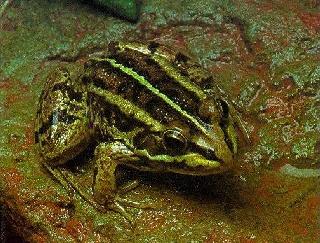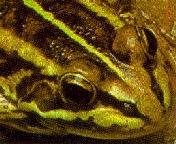 Picture ©Tony
Tilford, by permission.
Picture ©Tony
Tilford, by permission. Britain's Rarest Amphibian: The Pool Frog Rana lessonae (=Pelophylax lessonae)
 Picture ©Tony
Tilford, by permission.
Picture ©Tony
Tilford, by permission.
The pool frog (Rana lessonae)
is a member of a group of the genus Rana known as the
green frogs. The distribution of this group centres on Europe,
with the most well known and widely distributed species being the
marsh frog (Rana ridibunda), the Western marsh frog (Rana
perezi) and the pool frog (Rana lessonae). A number of
other closely related species are also known. The edible frog (Rana
esculenta), once thought to be a separate species, is now
believed to be a hybrid between the pool frog and marsh frog.
Edible frogs often cannot reproduce successfully with other
edible frogs, only with one of the parent species.
Follow this link for more information on the genetics of
the green frog group
In the nineteenth century, around 1840, considerable numbers of edible frogs were imported from France and Belgium, and released in Norfolk, in England. One colony of green frogs survived to the latter part of the 20th century, in a nature reserve in Norfolk. It was previously believed that these frogs originated from one of the introductions of continental stock. However, there is evidence of the presence of green frogs in Britain from literature of the 1770s, before any introductions are known to have taken place. It would appear that these frogs were widespread over the East Anglian fens, particularly in Cambridgeshire and Norfolk. Drainage of the fens may have led to the decline of the pool frog in Britain.
More recently, archaeologists have discovered pool frog bones in excavations in Norfolk, Cambridgeshire and Lincolnshire, and the native status of the Pool Frog is now accepted.
Unfortunately, the one remaining population in Norfolk suffered heavy declines, possibly caused by dry summers, overgrowth of ponds, or predation by fish and grass snakes. No signs of breeding have been seen since the early 1990s. The pool frog has gone from being an unprotected alien, (in fact, until recently it was illegal to release pool frogs into the wild) to Britain's rarest vertebrate.
English Nature, together with the British Herpetological Society, are hoping to re-establish the Norfolk colony. British herpetologists have been attempting to collect pool frogs for captive breeding, from the known site, but none have been located. At the time that the native status of the pool frog was being accepted, one male pool frog from this colony was being maintained in captivity by a herpetologist who collected this specimen from the Norfolk site. Pool frogs from Sweden, which are thought to be the most closely related to the British frogs, were brought to Britain for breeding with this lone male, nicknamed 'Lucky'. Unfortunately, these Swedish frogs failed to come into breeding condition. Though the last British pool frog died in 1999, having failed to breed with the closely related Swedish frogs, he did breed with some Dutch pool frogs, and his genes persist in these offspring.
In August 2005, pool frogs of Swedish origin were released at a site close to where pool frogs were last seen in Norfolk. These animals were collected in Sweden shortly before being released in Norfolk. This was reported in the national press- see for example these articles from the BBC and The Independent.
For further information on the ongoing conservation of the pool frog in the UK, read the Biodiversity Action Plan and English Nature's Reintroduction Strategy(897K PDF file). The English Nature report contains an excellent summary of the history and natural history of the pool frog in the UK.
